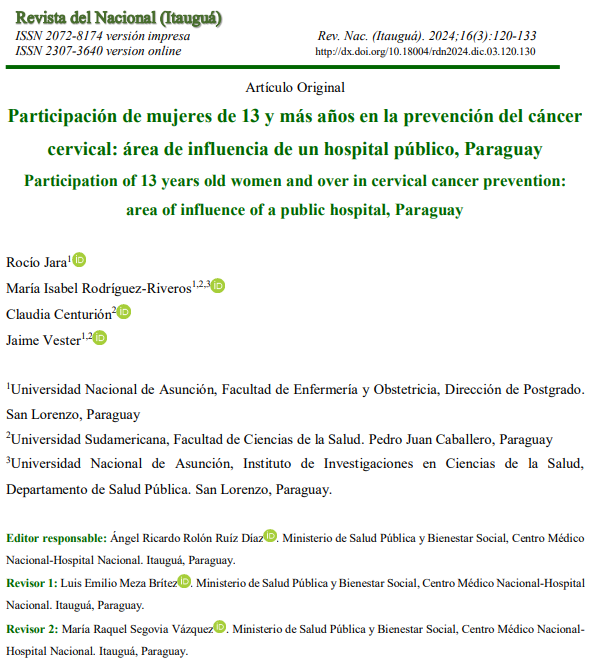Participation of 13 years old women and over in cervical cancer prevention: area of influence of a public hospital, Paraguay
Main Article Content
Abstract
Introduction: cervical cancer represents a serious public health problem despite being highly preventable.
Objective: to determine the clinical and epidemiological characteristics of the participation of women in the area of influence of a Public Hospital in the prevention of cervical cancer between the months of January to December of the years 2020 to 2021.
Methodology: non-experimental cross-sectional descriptive design, with a quantitative approach. The total number of women participating in the prevention of cervical cancer in the area of influence of the Public Hospital was included. Secondary data were used that were loaded into a previously prepared form.
Results: 61 % of the women were of 13 years old at risk, 83 % were not pregnant and 17 % were pregnant, 53 % had a history of PAP and 47 % did not, 86 % had a negative result for lesion, 9 % inflammatory and 4 % positive. Among the positive results, the predominant one was ASCUS with 47 %. The majority women had a negative PAP result. As a conclusion among women with positive results, there was a predominance of ASCUS diagnoses and in second place CIN I LSIL.
Conclusion: the features that were found to be significantly associated with the PAP result were: being part of the age group at risk and presence of pregnancy. It is suggested to continue emphasizing prevention and follow-up, to investigate the ages at risk and to include other variables of interest in future studies.
Article Details

This work is licensed under a Creative Commons Attribution 4.0 International License.
References
Organización Mundial de la Salud. Organización Panamericana de la Salud. Incorporación de la prueba del virus del papiloma humano en programas de prevención de cáncer cervicouterino. Whashington D.C.: OMS/OPS; 2016. p. 42–7. Disponible en: https://www3.paho.org/hq/index.php?option=com_docman&view=download&alias=36609-incorporacion-prueba-virus-papiloma-humano-programas-prevencion-cancer-cervicouterinomanual-gerentes-programas-salud-609&category_slug=guias-manuales3444&Itemid=270&lang=en
Cortés García CM. Cáncer de cuello uterino: una enfermedad de mujeres con perspectiva de género. Reflexiones para el trabajo en salud pública. Seminário Internacional Fazendo GêneroAnais Eletrônicos. 2013;10:2179–510. Disponible en: https://www.fg2013.wwc2017.eventos.dype.com.br/resources/anais/20/1381510088_ARQUIVO_cLAUDIAgARCIA.pdf
Organización Mundial de la Salud. Plan de Acción sobre la prevención y el control del cáncer cervicouterino. Whashington D.C.: PAHO; 2018. Disponible en: https://iris.paho.org/handle/10665.2/38574
Organización Mundial de la Salud. Nota de orientación de la OMS/OPS: prevención y control integrales del cáncer cervicouterino: un futuro más saludable para niñas y mujeres. Whashington D.C.: OPS; 2013. 16 p. Disponible en: https://iris.who.int/bitstream/handle/10665/85344/9789275317471_spa.pdf?sequence=1
Organización Mundial de la Salud. Cáncer de cuello uterino: nota descriptiva. 2023. Disponible en: https://www.who.int/es/news-room/fact- heets/detail/cervical-cancer
Bray F, Ferlay J, Soerjomataram I, Siegel RL, Torre LA, Jemal A. Global cancer statistics 2018: GLOBOCAN estimates of incidence and mortality worldwide for 36 cancers in 185 countries. CA Cancer J Clin. 2018;68(6):394–424. Disponible en: https://pubmed.ncbi.nlm.nih.gov/30207593/
World Health Organization. International Agency for Research on Cancer. Cervix uteri Source: Globocan 2018. 2019.876. Disponible en: https://gco.iarc.fr/today/data/factsheets/cancers/23- Cervix-uteri-fact-sheet.pdf
Noreña-Quiceno C, Stella Tamayo-Acevedo L. Cáncer de cuello uterino: análisis de la calidad deun programa. Aquichan. 2006;10(1):52–68.
Gobierno de Castilla-La Mancha. Dirección de Sanidad y Bienestar Social. Junta de Castilla y León. Estrategia regional contra el cáncer en Castilla y León. Castilla y León; 2007. 118 p. Disponible en: https://www.saludcastillayleon.es/institucion/es/publicaciones-consejeria/buscador/estrategiaregional-cancer-castilla-leon.ficheros/328113-Estrategia_cancer_pdf.pdf
Organización Mundial de la Salud. Organización Panamericana de la Salud. Incorporación de la prueba del virus del papiloma humano en programas de prevención de cáncer cervicouterino. Whashington D.C.: OMS/OPS; 2016. 77 p.
Organización Panamericana de la Salud. Organización Mundial de la Salud. Estrategia y plan de acción regional para la prevención y el control del cáncer cervicouterino en América Latina y el Caribe. Whashington D.C.: OPSOMS; 2008. 17 p.
Paraguay. Ministerio de Salud Pública y Bienestar Social. Manual nacional de normas y procedimientos para la prevención y el control del cáncer del tracto genital inferior femenino. Asunción: AGR Editorial; 2015. 84 p.
Barrientos Ramos KML. Evolución y perfil sociodemográfico de las mujeres que se realizaron tamizaje citológico de cuello uterino. Lima: Universidad Nacional Mayor de San Marco; 2021. Disponible en: https://cybertesis.unmsm.edu.pe/backend/api/core/bitstreams/506d84cd-dfae-430c9dd7-1d9e6645b846/content
Grandez Navarro CM. Características del Papanicolau en mujeres atendidas en el Centro de Salud de San Antonio. Perú: Universidad Científica del Perú; 2017. Disponible en: http://repositorio.ucp.edu.pe/bitstream/handle/UCP/117/GRANDEZ-Caracter%c3%adsticas-1-
Trabajo.pdf?sequence=1&isAllowed=y
Venegas G, Bendezu-Quispe G, Urrunaga-Pastor D, Alzamora MC, Franco-Liñan C, BenitesZapata VA. Factores asociados al resultado citológico positivo en pruebas de Papanicolau en mujeres atendidas en la Liga Peruana de Lucha contra el Cáncer. Rev Cuerpo Med HNAAA. 2021;14(4):484–90.
Aparicio Llanos A, Morera Salas M. Evaluation of the «early detection and opportune attention of cervicouterine cancer» program. Aten Primaria. 2009;41(6):300–5. doi: 10.1016/j.aprim.2008.10.018.
Atoche Quezada EM, Sánchez Valencia ME. Influencia de los factores socioculturales en las mujeres de 30-64 años para el rechazo del Papanicolaou e IVAA en el Hospital Distrital Jerusalén Trujillo-2020. Perú: Universidad Privada Antenor Orrego. 2021.

